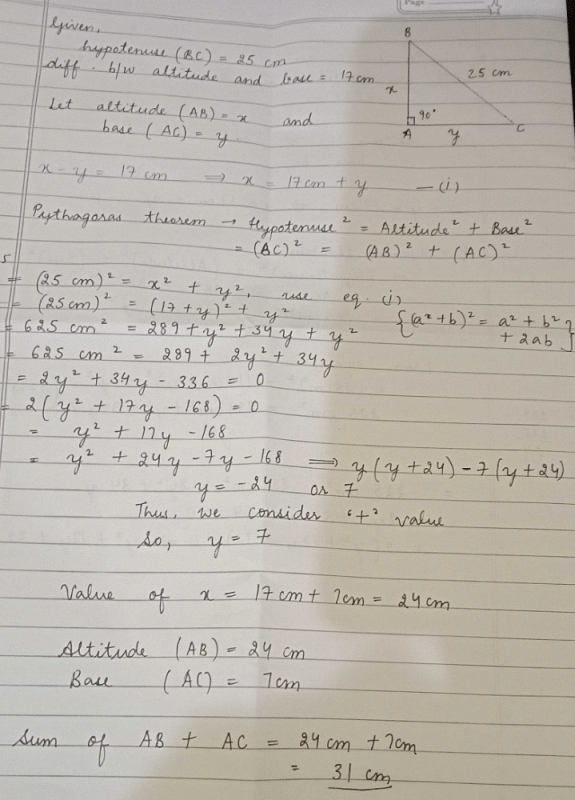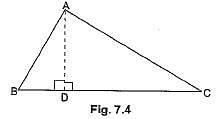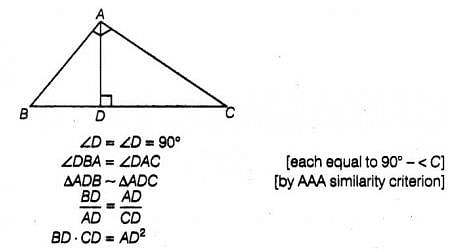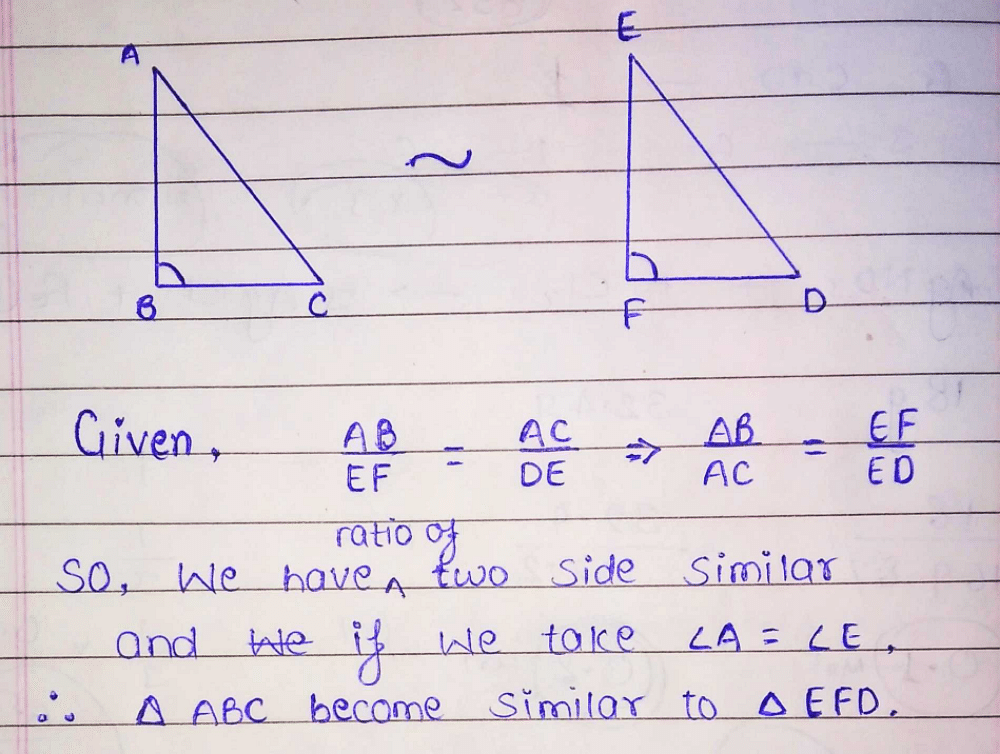All Exams >
SSS 1 >
Mathematics for SSS 1 >
All Questions
All questions of Triangles for SSS 1 Exam
| 1 Crore+ students have signed up on EduRev. Have you? Download the App |
Direction: In the following questions, A statement of Assertion (A) is followed by a statement of Reason (R). Mark the correct choice as.Assertion (A): Corresponding sides of two similar triangles are in the ratio of 2 : 3. If the area of the smaller triangle is 48 cm2, then the area of the larger triangle is 108 cm2.Reason (R): If D is a point on the side BC of a triangle ABC such that ∠ADC = ∠BAC, then CA2 = CB × CD.- a)Both A and R are true and R is the correct explanation of A
- b)Both A and R are true but R is NOT the correct explanation of A
- c)A is true but R is false
- d)A is false and R is True
Correct answer is option 'B'. Can you explain this answer?
Direction: In the following questions, A statement of Assertion (A) is followed by a statement of Reason (R). Mark the correct choice as.
Assertion (A): Corresponding sides of two similar triangles are in the ratio of 2 : 3. If the area of the smaller triangle is 48 cm2, then the area of the larger triangle is 108 cm2.
Reason (R): If D is a point on the side BC of a triangle ABC such that ∠ADC = ∠BAC, then CA2 = CB × CD.
a)
Both A and R are true and R is the correct explanation of A
b)
Both A and R are true but R is NOT the correct explanation of A
c)
A is true but R is false
d)
A is false and R is True
|
|
Krishna Iyer answered |
In case of assertion

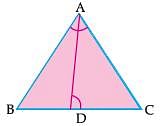
Let ΔABC and ΔDEF are two similar triangles.

Given that ar ΔABC = 48 cm2. Then,

Thus, the area of larger triangle is 108 cm2.
∴ Assertion is correct.
In case of reason:

In ΔBAC and ΔADC,
∠BAC= ∠ADC [Given]
∠BCA= ∠ACD [Common angle]
By AA similarity, ΔBAC ~ ΔADC
Thus,
CA/CD = BC/CA
∴ Reason is correct.
Hence, both assertion and reason are correct but reason is not the correct explanation for assertion.
Which geometric figures are always similar?- a)Circles
- b)Circles and all regular polygons
- c)Circles and triangles
- d)Regular polygons
Correct answer is option 'B'. Can you explain this answer?
Which geometric figures are always similar?
a)
Circles
b)
Circles and all regular polygons
c)
Circles and triangles
d)
Regular polygons
|
|
Raghav Bansal answered |
It can be found that circles map one onto another.So they are similar figures. A regular polygon is a polygon which has the same sides and equal measures of angles. So they are also similar.
In triangle ABC, if AB = 6√3 cm, AC = 12 cm and BC cm, then ∠B is - a)120°
- b)60°
- c)90°
- d)45°
Correct answer is option 'C'. Can you explain this answer?
In triangle ABC, if AB = 6√3 cm, AC = 12 cm and BC cm, then ∠B is
a)
120°
b)
60°
c)
90°
d)
45°
|
|
Gaurav Kumar answered |

Here largest side is 12 cm.
If the square of the hypotenuse is equal to the square of the other two sides, then it is a right-angled triangle.
If the square of the hypotenuse is equal to the square of the other two sides, then it is a right-angled triangle.
∴ c2 = a2 + b2
AC2 = AB2 + BC2
(12)2 = (63)2 + (6)2
44 = 36 × 3 + 36
144 = 108 + 36
144 = 144
∴ ∆ABC is a right angled triangle and angle opposite to hypotenuse, ∠B = 90°.
ΔABC ~ ΔPQR, ∠B = 50° and ∠C = 70° then ∠P is equal to- a)50°
- b)60°
- c)40°
- d)70°
Correct answer is option 'B'. Can you explain this answer?
ΔABC ~ ΔPQR, ∠B = 50° and ∠C = 70° then ∠P is equal to
a)
50°
b)
60°
c)
40°
d)
70°
|
|
Radha Iyer answered |
Similar triangles have corresponding angles equal. So Angle Q=Angle B = 50° and Angle R = Angle C = 70° . So by angle sum property, Angle P+Angle Q +Angle R = 180°
Angle P=180° - 50° - 70° = 60°
Angle P=180° - 50° - 70° = 60°
In an equilateral triangle ABC, if AD ⊥ BC. Then- a)3AB2 = 4AD2
- b)2AB2 = 3AD2
- c)3AB2 = 2AD2
- d)4AB2 = 3AD2
Correct answer is option 'A'. Can you explain this answer?
In an equilateral triangle ABC, if AD ⊥ BC. Then
a)
3AB2 = 4AD2
b)
2AB2 = 3AD2
c)
3AB2 = 2AD2
d)
4AB2 = 3AD2
|
|
Raghav Bansal answered |
∆ ABC, in which sides are AB=BC= AC= a units and AD is perpendicular to BC ,
In ∆ADB ,
AB²= AD²+ BD² (by Pythagoras theorem)
a² = AD² + (a/2)² [BD= 1/2BC, since in an equilateral triangle altitude AD is perpendicular bisector of BC ]
a²- a²/4 =AD²
⇒ ( 4a²-a²)/4 = AD²
⇒ 3a² /4 = AD²
⇒ 3AB²/4= AD² [ AB= a]
⇒ 3AB²= 4AD²
Two congruent triangles are actually similar triangles with the ratio of corresponding sides as.- a)1:2
- b)1:1
- c)1:3
- d)2:1
Correct answer is option 'B'. Can you explain this answer?
Two congruent triangles are actually similar triangles with the ratio of corresponding sides as.
a)
1:2
b)
1:1
c)
1:3
d)
2:1
|
|
Pushkar tiwari answered |
Similar Triangles and Corresponding Sides
Similar triangles are those triangles that have the same shape but may have different sizes. When two triangles are similar, the corresponding angles are the same, and the corresponding sides are proportional. In other words, the ratio of the lengths of the corresponding sides is the same for all pairs of corresponding sides. This ratio is called the scale factor.
Given the statement that "Two congruent triangles are actually similar triangles with the ratio of corresponding sides as," we are asked to determine the scale factor for the corresponding sides of the two triangles.
Option B is the correct answer, and the scale factor is 1:1. This means that the corresponding sides of the two triangles are equal in length.
Explanation of Other Options:
a) 1:2 - This means that the corresponding sides of one triangle are twice as long as the corresponding sides of the other triangle. Therefore, the triangles are not congruent, but they are similar.
c) 1:3 - This means that the corresponding sides of one triangle are three times as long as the corresponding sides of the other triangle. Therefore, the triangles are not congruent, but they are similar.
d) 2:1 - This means that the corresponding sides of one triangle are half as long as the corresponding sides of the other triangle. Therefore, the triangles are not congruent, but they are similar.
Conclusion:
In summary, when two triangles are congruent, they are also similar with a scale factor of 1:1. This means that the corresponding sides of the triangles are equal in length.
Similar triangles are those triangles that have the same shape but may have different sizes. When two triangles are similar, the corresponding angles are the same, and the corresponding sides are proportional. In other words, the ratio of the lengths of the corresponding sides is the same for all pairs of corresponding sides. This ratio is called the scale factor.
Given the statement that "Two congruent triangles are actually similar triangles with the ratio of corresponding sides as," we are asked to determine the scale factor for the corresponding sides of the two triangles.
Option B is the correct answer, and the scale factor is 1:1. This means that the corresponding sides of the two triangles are equal in length.
Explanation of Other Options:
a) 1:2 - This means that the corresponding sides of one triangle are twice as long as the corresponding sides of the other triangle. Therefore, the triangles are not congruent, but they are similar.
c) 1:3 - This means that the corresponding sides of one triangle are three times as long as the corresponding sides of the other triangle. Therefore, the triangles are not congruent, but they are similar.
d) 2:1 - This means that the corresponding sides of one triangle are half as long as the corresponding sides of the other triangle. Therefore, the triangles are not congruent, but they are similar.
Conclusion:
In summary, when two triangles are congruent, they are also similar with a scale factor of 1:1. This means that the corresponding sides of the triangles are equal in length.
In the following figure, find the value of x.
- a)65°
- b)70°
- c)80°
- d)30°
Correct answer is option 'B'. Can you explain this answer?
In the following figure, find the value of x.
a)
65°
b)
70°
c)
80°
d)
30°
|
|
Arun Sharma answered |
The triangles are similar by SAS criterion, So we have, Angle A+Angle B + Angle C=180
x=180-30-80=70 degrees
x=180-30-80=70 degrees
In the given figure, T and B are right angles. If the lengths of AT, BC and AS (in centimeters) are 15, 16 and 17 respectively, then the length of TC (in centimeters) is:
- a)18
- b)12
- c)19
- d)16
Correct answer is option 'C'. Can you explain this answer?
In the given figure, T and B are right angles. If the lengths of AT, BC and AS (in centimeters) are 15, 16 and 17 respectively, then the length of TC (in centimeters) is:
a)
18
b)
12
c)
19
d)
16
|
|
Anjana Khatri answered |
Here is the solution to your question:


So, the Correct Answer is
Option C. P.S. You can understand all the concepts of Class 10 by going through this document:
In the given figure use the similarity of the given triangles to find the value of BD, ΔABC ~ ΔBDC = 90° AB=3, BC=4,AD=2 BD=?
- a)6
- b)10
- c)8/3
- d)5
Correct answer is option 'C'. Can you explain this answer?
In the given figure use the similarity of the given triangles to find the value of BD, ΔABC ~ ΔBDC = 90° AB=3, BC=4,AD=2 BD=?
a)
6
b)
10
c)
8/3
d)
5
|
|
Gaurav Kumar answered |
Solution :
The correct option is Option C.
∆ ABC ~ ∆ BDC = AD/AB = BD/BC = ⅔ = BD/4 = BD = 8/3
If ΔDEF ~ ΔABC and DE=AB, what is the relation between the two triangles?- a)They are both right triangles.
- b)ΔDEF ≠ ΔABC
- c)They are both equilateral.
- d)ΔDEF ≅ ΔABC
Correct answer is option 'D'. Can you explain this answer?
If ΔDEF ~ ΔABC and DE=AB, what is the relation between the two triangles?
a)
They are both right triangles.
b)
ΔDEF ≠ ΔABC
c)
They are both equilateral.
d)
ΔDEF ≅ ΔABC
|
|
Naina Sharma answered |
Since DE=AB means that there ratio is 1 which means corresponding sides are equal.Two triangles are said to be similar if their corresponding angles are congruent and the corresponding sides are in proportion . In other words, similar triangles are the same shape, but not necessarily the same size. The triangles are congruent if, in addition to this, their corresponding sides are of equal length.So they are congruent.
D and E are respectively the points on the sides AB and AC of a triangle ABC such that AD = 3 cm, BD = 5 cm, BC = 12.8 cm and DE || BC. Then length of DE (in cm) is- a)4.8 cm
- b)7.6 cm
- c)19.2 cm
- d)2.5 cm
Correct answer is option 'A'. Can you explain this answer?
D and E are respectively the points on the sides AB and AC of a triangle ABC such that AD = 3 cm, BD = 5 cm, BC = 12.8 cm and DE || BC. Then length of DE (in cm) is
a)
4.8 cm
b)
7.6 cm
c)
19.2 cm
d)
2.5 cm
|
|
Meera Rana answered |
GIVEN: In Δ ABC, D and E are points on AB and AC , DE || BC and AD = 2.4 cm, AE = 3.2 cm, DE = 2 cm and BE = 5 cm.
In Δ ADE and Δ ABC,
∠ADE =∠ABC (corresponding angles)
[DE || BC, AB is transversal]
∠AED =∠ACB (corresponding angles)
[DE || BC, AC is transversal]
So, Δ ADE ~ Δ ABC (AA similarity)
Therefore, AD/AB = AE/AC = DE/BC
[In similar triangles corresponding sides are proportional]
AD/AB = DE/BC
2.4/(2.4+DB) = 2/5
2.4 × 5 = 2(2.4+ DB)
12 = 4.8 + 2DB
12 - 4.8 = 2DB
7.2 = 2DB
DB = 7.2/2
DB = 3.6 cm
Similarly, AE/AC = DE/BC
3.2/(3.2+EC) = 2/5
3.2 × 5 = 2(3.2+EC)
16 = 6.4 + 2EC
16 - 6.4 = 2EC
9.6 = 2EC
EC = 9.6/2
EC = 4.8 cm
Hence,BD = 3.6 cm and CE = 4.8 cm.
In Δ ADE and Δ ABC,
∠ADE =∠ABC (corresponding angles)
[DE || BC, AB is transversal]
∠AED =∠ACB (corresponding angles)
[DE || BC, AC is transversal]
So, Δ ADE ~ Δ ABC (AA similarity)
Therefore, AD/AB = AE/AC = DE/BC
[In similar triangles corresponding sides are proportional]
AD/AB = DE/BC
2.4/(2.4+DB) = 2/5
2.4 × 5 = 2(2.4+ DB)
12 = 4.8 + 2DB
12 - 4.8 = 2DB
7.2 = 2DB
DB = 7.2/2
DB = 3.6 cm
Similarly, AE/AC = DE/BC
3.2/(3.2+EC) = 2/5
3.2 × 5 = 2(3.2+EC)
16 = 6.4 + 2EC
16 - 6.4 = 2EC
9.6 = 2EC
EC = 9.6/2
EC = 4.8 cm
Hence,BD = 3.6 cm and CE = 4.8 cm.
If PQR is an isosceles triangle and M is a point on QR such that PM⊥QR,then- a)PQ2−PM2 = QM2−MR2.
- b)PQ2+PM2 = QM.MR.
- c)PQ2−PR2 = QM2 − MR2
- d)PQ2−PM2 = QM.MR.
Correct answer is option 'C'. Can you explain this answer?
If PQR is an isosceles triangle and M is a point on QR such that PM⊥QR,then
a)
PQ2−PM2 = QM2−MR2.
b)
PQ2+PM2 = QM.MR.
c)
PQ2−PR2 = QM2 − MR2
d)
PQ2−PM2 = QM.MR.
|
|
Krishna Iyer answered |
Since, in a triangle the sum of squares of any wo sides is equal to twice the square of half of the third side together with twice the square of the median bisecting it.
In ΔPQM,
In ΔPQM,
In ΔLMN and ΔPQR, ∠L = ∠P, ∠N = ∠R and MN = 2QR. Then the two triangles are- a)Congruent but not similar
- b)Similar but not congruent
- c)neither congruent nor similar
- d)Congrunt as well as similar
Correct answer is option 'B'. Can you explain this answer?
In ΔLMN and ΔPQR, ∠L = ∠P, ∠N = ∠R and MN = 2QR. Then the two triangles are
a)
Congruent but not similar
b)
Similar but not congruent
c)
neither congruent nor similar
d)
Congrunt as well as similar
|
|
Anshu chawla answered |
In what context or topic would you like me to respond? Please provide more information so I can provide a relevant answer.
In the given figure perpendiculars are dropped on the common base BD of the given two triangles. AE = 2cm, CF = 3cm 

- a)1/3
- b)2/3
- c)4/9
- d)1/9
Correct answer is option 'B'. Can you explain this answer?
In the given figure perpendiculars are dropped on the common base BD of the given two triangles. AE = 2cm, CF = 3cm 
a)
1/3
b)
2/3
c)
4/9
d)
1/9
|
|
Gaurav Kumar answered |
Area of triangle = 1/2 *base*height
Area of ABD=1/2 *BD*2
Area of BDC=1/2*BD*3

Area of ABD=1/2 *BD*2
Area of BDC=1/2*BD*3

ΔABC ~ ΔDEF Perimeter( ΔABC )= 15 cm, Perimeter( DEF )=25 cm.If AB= 6 cm, then find DE.- a)14
- b)12
- c)10
- d)16
Correct answer is option 'C'. Can you explain this answer?
ΔABC ~ ΔDEF Perimeter( ΔABC )= 15 cm, Perimeter( DEF )=25 cm.If AB= 6 cm, then find DE.
a)
14
b)
12
c)
10
d)
16
|
|
Gaurav Kumar answered |
Ratios of perimeter of similar triangles are equal to the ratio of their sides.
So Perimeter of ABC/perimeter of DEF=15/25=⅗
AB/DE=⅗
DE=6*5/3=10
So Perimeter of ABC/perimeter of DEF=15/25=⅗
AB/DE=⅗
DE=6*5/3=10
In triangles ABC and DEF, ∠B = ∠E, ∠F = ∠C and AB = 3DE. Then, the two triangles are- a)congruent but not similar
- b)similar but not congruent
- c)neither congruent nor similar
- d)congruent as well as similar
Correct answer is option 'B'. Can you explain this answer?
In triangles ABC and DEF, ∠B = ∠E, ∠F = ∠C and AB = 3DE. Then, the two triangles are
a)
congruent but not similar
b)
similar but not congruent
c)
neither congruent nor similar
d)
congruent as well as similar
|
|
Kiran Mehta answered |
to be congruent, the conditions are
S S S - three sides
S A S - two sides and the included angle
A S A - two angles and one side
R H S - R H S - Right angle, Hypotenuse and one side
But to be similar,
A A A means 3 angles
A A means only two angles ....
in both triangles should be equal.
In the problem, equality of two angles is given, but equality of sides is not given.
So, given triangles are not congruent.
But they are similar.
S S S - three sides
S A S - two sides and the included angle
A S A - two angles and one side
R H S - R H S - Right angle, Hypotenuse and one side
But to be similar,
A A A means 3 angles
A A means only two angles ....
in both triangles should be equal.
In the problem, equality of two angles is given, but equality of sides is not given.
So, given triangles are not congruent.
But they are similar.
In the adjoining figure D, E and F are the mid-points of the sides BC, AC and AB respectively. ΔDEF is congruent to triangle :

- a)ABC
- b)AEF
- c)AFE, BFD and CDE
- d)CDE , BFD
Correct answer is option 'C'. Can you explain this answer?
In the adjoining figure D, E and F are the mid-points of the sides BC, AC and AB respectively. ΔDEF is congruent to triangle :
a)
ABC
b)
AEF
c)
AFE, BFD and CDE
d)
CDE , BFD
|
|
Raghav Bansal answered |
Given :△ABC, F, D and E are mid points of AB, BC, CA respectively.
Using mid point theorem we prove that □AEFD, □DBFF and □DCEF are parallelograms. The diagonal of a parallelogram divides the parallelogram into two congruent triangles. So all triangles are congruent to each other. So ΔDEF is congruent to
△AFE, △BFD and △CDE
Using mid point theorem we prove that □AEFD, □DBFF and □DCEF are parallelograms. The diagonal of a parallelogram divides the parallelogram into two congruent triangles. So all triangles are congruent to each other. So ΔDEF is congruent to
△AFE, △BFD and △CDE
If ΔPQR ~ ΔXYZ , ∠Q = 50° , ∠R = 70° then ∠X is equal to :- a)50°
- b)60°
- c)70°
- d)120°
Correct answer is option 'B'. Can you explain this answer?
If ΔPQR ~ ΔXYZ , ∠Q = 50° , ∠R = 70° then ∠X is equal to :
a)
50°
b)
60°
c)
70°
d)
120°

|
Yogita Rishi answered |
Angle Q = 50
Angle R= 70
Angle p = ?
now
we know that the angle sum property of a triangle is equal to 180 degree
Angle Q + angle R+ angle P = 180
50 + 70 + angle P = 180
120 + angle P = 180
angle P = 180 - 120
-Angle p = 60
as they both are similar so by corresponding parts of similar triangle
Angle P = Angle X
Angle x = 60....
Angle R= 70
Angle p = ?
now
we know that the angle sum property of a triangle is equal to 180 degree
Angle Q + angle R+ angle P = 180
50 + 70 + angle P = 180
120 + angle P = 180
angle P = 180 - 120
-Angle p = 60
as they both are similar so by corresponding parts of similar triangle
Angle P = Angle X
Angle x = 60....
In the figure given below, if DE || BC, then x equals :
- a)2 cm
- b)4 cm
- c)6.7 cm
- d)3 cm
Correct answer is option 'C'. Can you explain this answer?
In the figure given below, if DE || BC, then x equals :
a)
2 cm
b)
4 cm
c)
6.7 cm
d)
3 cm
|
|
Pooja Shah answered |
We have Angle ADE= Angle ABC
And ANGLE A is common, So by AA criterion of similarity the two triangles are similar so AD/AB=DE/BC
x=5*4/3=6.7
And ANGLE A is common, So by AA criterion of similarity the two triangles are similar so AD/AB=DE/BC
x=5*4/3=6.7

- a)∠B=∠D.
- b)∠B=∠E.
- c)∠A=∠D.
- d)∠A=∠F.
Correct answer is option 'A'. Can you explain this answer?
a)
∠B=∠D.
b)
∠B=∠E.
c)
∠A=∠D.
d)
∠A=∠F.
|
|
Manisha reddy answered |
Given information:
- QR < 2pq="" -="" />
- PR = PQ + 10
- Perimeter = 40
To find:
- Smallest side of the triangle PQR
Solution:
Let's assume that PQ = x, QR = y, and PR = z.
Using the given information, we can write two equations based on the lengths of the sides:
1. y = 2x - 2 (QR is less than twice the length of PQ by 2 cm)
2. z = x + 10 (PR exceeds the length of PQ by 10 cm)
We also know that the perimeter of the triangle is 40 cm:
x + y + z = 40
Substituting the values of y and z from equations (1) and (2) into equation (3), we get:
x + (2x - 2) + (x + 10) = 40
Simplifying the equation, we get:
4x + 8 = 40
4x = 32
x = 8
Therefore, the length of the smallest side of the triangle PQR is PQ = x = 8 cm.
Answer: Option (B) 8 cm.
- QR < 2pq="" -="" />
- PR = PQ + 10
- Perimeter = 40
To find:
- Smallest side of the triangle PQR
Solution:
Let's assume that PQ = x, QR = y, and PR = z.
Using the given information, we can write two equations based on the lengths of the sides:
1. y = 2x - 2 (QR is less than twice the length of PQ by 2 cm)
2. z = x + 10 (PR exceeds the length of PQ by 10 cm)
We also know that the perimeter of the triangle is 40 cm:
x + y + z = 40
Substituting the values of y and z from equations (1) and (2) into equation (3), we get:
x + (2x - 2) + (x + 10) = 40
Simplifying the equation, we get:
4x + 8 = 40
4x = 32
x = 8
Therefore, the length of the smallest side of the triangle PQR is PQ = x = 8 cm.
Answer: Option (B) 8 cm.
Which pair of the given quadrilaterals is similar?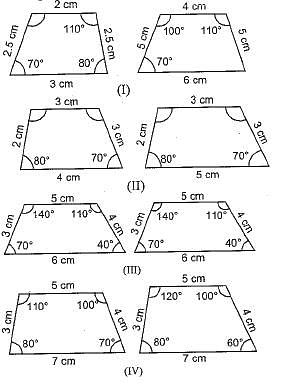
a)I only
b)III onlyc)I and IIId)IVCorrect answer is option 'C'. Can you explain this answer?

|
|
Naina Sharma answered |
Quadrilaterals are similar if their angles are equal and corresponding sides are proportional.
In the given figure, AD/BD = AE/EC and ∠ADE = 70°, ∠BAC = 50°, then angle ∠BCA =

- a)70°
- b)50°
- c)80°
- d)60°
Correct answer is option 'D'. Can you explain this answer?
In the given figure, AD/BD = AE/EC and ∠ADE = 70°, ∠BAC = 50°, then angle ∠BCA =


a)
70°
b)
50°
c)
80°
d)
60°
|
|
Trisha sharma answered |
Explanation: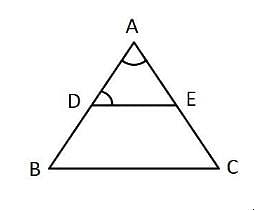


By converse of Thale’s theorem DE II BC
∠ADE = ∠ABC = 70 degree
Given ∠BAC = 50 degree

You can read Important Definitions & Formulas related to Triangles through the document:
The areas of two similar triangles are 100cm2 and 49 cm2. If the altitude of the larger triangle is 5 cm, then the corresponding altitude of the other triangle is equal to- a)3.5 cm.
- b)3.9 cm.
- c)5.4 cm.
- d)4.5 cm.
Correct answer is option 'A'. Can you explain this answer?
The areas of two similar triangles are 100cm2 and 49 cm2. If the altitude of the larger triangle is 5 cm, then the corresponding altitude of the other triangle is equal to
a)
3.5 cm.
b)
3.9 cm.
c)
5.4 cm.
d)
4.5 cm.
|
|
Krishna Iyer answered |
Let the two similar triangles be ΔABC and ΔDEF such that ar(ΔABC) = 100 cm2 and ar(ΔDEF) = 49 cm2.
Let AM and DN be the respective altitudes of ΔABC and ΔDEF.
Since the ratio of the areas of two similar triangles is equal to the ratio of the squares of their corresponding altitudes
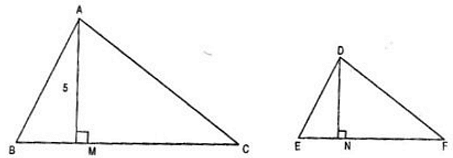
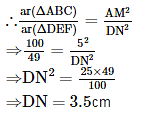
Let AM and DN be the respective altitudes of ΔABC and ΔDEF.
Since the ratio of the areas of two similar triangles is equal to the ratio of the squares of their corresponding altitudes
If ΔABC ~ ΔEDF then which of the following is not true?
- a)BC . EF = AC . FD
- b)AB . EF = AC . DE
- c)BC . DE = AB . EF
- d)BC . DE = AB . FD
Correct answer is option 'C'. Can you explain this answer?
If ΔABC ~ ΔEDF then which of the following is not true?
a)
BC . EF = AC . FD
b)
AB . EF = AC . DE
c)
BC . DE = AB . EF
d)
BC . DE = AB . FD
|
|
Anita Menon answered |
Since △ABC~△EDF
Then, AB/ED = BC/DF = AC/EF
A) BC/DF = AC/EF
⇒BC.EF=AC.FD
So, A) is true
B) AB/ED = AC/EF
⇒AB.EF=AC.DE
So,B) is true
D) AB/ED = BC/DF
BC.DE=AB.EF
So, D) is not true
Therefore, Option C is not true
In triangle MNS, A and B are points on the sides MN, NS respectively.  Then AB is …………………. to NS :
Then AB is …………………. to NS :- a)Not Perpendicular
- b)Parallel
- c)Perpendicular
- d)Not Parallel
Correct answer is option 'B'. Can you explain this answer?
In triangle MNS, A and B are points on the sides MN, NS respectively.  Then AB is …………………. to NS :
Then AB is …………………. to NS :
a)
Not Perpendicular
b)
Parallel
c)
Perpendicular
d)
Not Parallel
|
|
Anita Menon answered |
In ∆MNS we have,
→ AN = 1/2(MN)
→ AN = (1/2)(MA + AN)
→ AN = (1/2)MA + (1/2)AN
→ AN - (1/2)AN = (1/2)MA
→ AN[1 - (1/2)] = (1/2)MA
→ (1/2)AN = (1/2)MA
→ AN = MA
so, A is mid point of MN .
→ AN = (1/2)(MA + AN)
→ AN = (1/2)MA + (1/2)AN
→ AN - (1/2)AN = (1/2)MA
→ AN[1 - (1/2)] = (1/2)MA
→ (1/2)AN = (1/2)MA
→ AN = MA
so, A is mid point of MN .
similarly,
→ BS = (1/2)(MS)
→ BS = (1/2)(MS)
so, B is mid point of MS .
since AB is a line segment joining the mid points of two sides of ∆MNS .
therefore, → AB || NS { According to Mid point theorem the line segment joining the mid points of two sides of a triangle is parallel to the third side . }
Triangle ABC is an isosceles right triangle right angled at B.DE is a line parallel to BC which intersects AB in D and AC in E.What ratio are the sides of triangle ADE in?- a)3:4:5
- b)1:1:1
- c)1:1:√2
- d)1:√3:2
Correct answer is option 'C'. Can you explain this answer?
Triangle ABC is an isosceles right triangle right angled at B.DE is a line parallel to BC which intersects AB in D and AC in E.What ratio are the sides of triangle ADE in?
a)
3:4:5
b)
1:1:1
c)
1:1:√2
d)
1:√3:2
|
|
Pooja Shah answered |
Since AB =BC and the triangles are similar, AB/AD=BC/DE
Gives AD=DE
So by Pythagoras theorem,
H2 = P2 + B2
H2 = 2x2
H = √2x
So the sides are in the ratio x:x: √2x which is 1:1: √2
Gives AD=DE
So by Pythagoras theorem,
H2 = P2 + B2
H2 = 2x2
H = √2x
So the sides are in the ratio x:x: √2x which is 1:1: √2
The line segments joining the mid points of the sides of a triangle form four triangles each of which is :- a)Similar to the original triangle
- b)Congruent to the original triangle
- c)An equilateral triangle
- d)An isosceles triangle
Correct answer is option 'A'. Can you explain this answer?
The line segments joining the mid points of the sides of a triangle form four triangles each of which is :
a)
Similar to the original triangle
b)
Congruent to the original triangle
c)
An equilateral triangle
d)
An isosceles triangle
|
|
Krishna Iyer answered |
Given :△ABC, D, E and F are mid points of AB, BC, CA respectively.
Using mid point theorem we prove that □ADEF, □DBEF and □DECF are parallelograms. The diagonal of a parallelogram divides the parallelogram into two congruent triangles. So all triangles are congruent to each other. And each small triangle is similar to the original triangle.
Using mid point theorem we prove that □ADEF, □DBEF and □DECF are parallelograms. The diagonal of a parallelogram divides the parallelogram into two congruent triangles. So all triangles are congruent to each other. And each small triangle is similar to the original triangle.
A square and a rhombus are always - a)similar
- b)congruent
- c)similar but not congruent
- d)neither similar nor congruent
Correct answer is option 'D'. Can you explain this answer?
A square and a rhombus are always
a)
similar
b)
congruent
c)
similar but not congruent
d)
neither similar nor congruent
|
|
Ishan Yadav answered |
Square and Rhombus
A square is a four-sided polygon with all sides equal in length and all angles equal to 90 degrees. A rhombus is also a four-sided polygon with all sides equal in length, but its opposite angles are equal, and they do not necessarily equal 90 degrees.
Similarity and Congruence
Similarity and congruence are two important concepts in geometry. Similar figures have the same shape but different sizes, while congruent figures have the same shape and size.
Square and Rhombus Similarity
A square and a rhombus are not always similar. Although a square and a rhombus both have four sides of equal length, they have different angles. A square has four right angles of 90 degrees each, while a rhombus has two acute angles and two obtuse angles.
Square and Rhombus Congruence
A square and a rhombus are not always congruent. While they both have four sides of equal length, their angles are different. A square has four right angles of 90 degrees each, while a rhombus has two acute angles and two obtuse angles.
Conclusion
In conclusion, a square and a rhombus are neither similar nor congruent because they have different angles, despite having equal sides. Therefore, the correct answer is option D.
A square is a four-sided polygon with all sides equal in length and all angles equal to 90 degrees. A rhombus is also a four-sided polygon with all sides equal in length, but its opposite angles are equal, and they do not necessarily equal 90 degrees.
Similarity and Congruence
Similarity and congruence are two important concepts in geometry. Similar figures have the same shape but different sizes, while congruent figures have the same shape and size.
Square and Rhombus Similarity
A square and a rhombus are not always similar. Although a square and a rhombus both have four sides of equal length, they have different angles. A square has four right angles of 90 degrees each, while a rhombus has two acute angles and two obtuse angles.
Square and Rhombus Congruence
A square and a rhombus are not always congruent. While they both have four sides of equal length, their angles are different. A square has four right angles of 90 degrees each, while a rhombus has two acute angles and two obtuse angles.
Conclusion
In conclusion, a square and a rhombus are neither similar nor congruent because they have different angles, despite having equal sides. Therefore, the correct answer is option D.
In ΔABC, AB = 3 cm, AC = 4 cm and AD is the bisector of ∠A. Then, BD : DC is :
- a)9 : 16
- b)16 : 9
- c)3 : 4
- d)4 : 3
Correct answer is option 'C'. Can you explain this answer?
In ΔABC, AB = 3 cm, AC = 4 cm and AD is the bisector of ∠A. Then, BD : DC is :
a)
9 : 16
b)
16 : 9
c)
3 : 4
d)
4 : 3
|
|
Amrutha Banerjee answered |
Recent years, there has been an increasing focus on mental health and the importance of taking care of it. This is due to a growing recognition of the impact mental health has on overall well-being and the understanding that mental health issues are common and can affect anyone.
One reason for the increased focus on mental health is the rising prevalence of mental health disorders. According to the World Health Organization, one in four people in the world will be affected by mental or neurological disorders at some point in their lives. This means that mental health issues are widespread and can have a significant impact on individuals, families, and communities.
Another reason for the increased focus on mental health is the growing understanding of the link between mental health and physical health. Research has shown that mental health issues can lead to a range of physical health problems, including heart disease, diabetes, and obesity. Conversely, taking care of mental health can improve physical health outcomes and overall well-being.
Additionally, there has been a greater recognition of the stigma surrounding mental health and a push for more open discussions and conversations. People are becoming more willing to share their experiences with mental health and seek help when needed. This increased openness has contributed to a greater understanding and acceptance of mental health issues, leading to more resources and support being available.
In recent years, there has also been a growing emphasis on mental health in the workplace. Employers are recognizing the importance of supporting their employees' mental well-being and implementing measures to promote mental health in the workplace. This includes initiatives such as employee assistance programs, mental health training for managers, and creating a supportive work environment.
Overall, the increased focus on mental health in recent years is a positive development. It has led to greater awareness, understanding, and support for mental health issues. However, there is still work to be done to ensure that everyone has access to the resources and support they need for their mental well-being.
One reason for the increased focus on mental health is the rising prevalence of mental health disorders. According to the World Health Organization, one in four people in the world will be affected by mental or neurological disorders at some point in their lives. This means that mental health issues are widespread and can have a significant impact on individuals, families, and communities.
Another reason for the increased focus on mental health is the growing understanding of the link between mental health and physical health. Research has shown that mental health issues can lead to a range of physical health problems, including heart disease, diabetes, and obesity. Conversely, taking care of mental health can improve physical health outcomes and overall well-being.
Additionally, there has been a greater recognition of the stigma surrounding mental health and a push for more open discussions and conversations. People are becoming more willing to share their experiences with mental health and seek help when needed. This increased openness has contributed to a greater understanding and acceptance of mental health issues, leading to more resources and support being available.
In recent years, there has also been a growing emphasis on mental health in the workplace. Employers are recognizing the importance of supporting their employees' mental well-being and implementing measures to promote mental health in the workplace. This includes initiatives such as employee assistance programs, mental health training for managers, and creating a supportive work environment.
Overall, the increased focus on mental health in recent years is a positive development. It has led to greater awareness, understanding, and support for mental health issues. However, there is still work to be done to ensure that everyone has access to the resources and support they need for their mental well-being.
In the given figure ΔABC ~ ΔBDC = 90° each. Choose the correct similarity from the given choices.
- a)ΔABC ~ ΔCBD
- b)ΔABC ~ ΔDCB
- c)ΔABC ~ ΔBCD
- d)ΔABC ~ ΔBDC
Correct answer is option 'D'. Can you explain this answer?
In the given figure ΔABC ~ ΔBDC = 90° each. Choose the correct similarity from the given choices.
a)
ΔABC ~ ΔCBD
b)
ΔABC ~ ΔDCB
c)
ΔABC ~ ΔBCD
d)
ΔABC ~ ΔBDC
|
|
Naina Sharma answered |
We have Angle C common and Angle B = Angle D
So in similarity we write the name of the triangle in such an order in which the corresponding alphabets denote equal angles . this means that ΔABC ~ ΔBDC that says Angle A = Angle B, Angle B = Angle D, and Angle C = Angle C
So in similarity we write the name of the triangle in such an order in which the corresponding alphabets denote equal angles . this means that ΔABC ~ ΔBDC that says Angle A = Angle B, Angle B = Angle D, and Angle C = Angle C
A semicircle is drawn on AC. Two chords AB and BC of length 8 cm and 6 cm respectively are drawn in the semicircle. What is the measure of the diameter of the circle?- a)14 cm.
- b)10 cm.
- c)12 cm.
- d)11 cm.
Correct answer is option 'B'. Can you explain this answer?
A semicircle is drawn on AC. Two chords AB and BC of length 8 cm and 6 cm respectively are drawn in the semicircle. What is the measure of the diameter of the circle?
a)
14 cm.
b)
10 cm.
c)
12 cm.
d)
11 cm.
|
|
Krishna Iyer answered |
The diameter of circle is AC. Here ∠ABC is angle of semicircle.
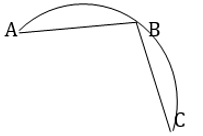
AB ∴ ∠ ABC = 90° ∴ Δ ABC is aright angled triangle.

 10 cm
10 cm
AB ∴ ∠ ABC = 90° ∴ Δ ABC is aright angled triangle.

 10 cm
10 cmIn right triangle ABC, right angled at A,A perpendicular is dropped from A to BC, meeting BC at D. Then which of the following is true?- a)ΔADC ~ ΔABD
- b)ΔDCA ~ ΔDABD
- c)ΔDAC ~ ΔDABD
- d)ΔDAC ~ ΔDABA
Correct answer is option 'D'. Can you explain this answer?
In right triangle ABC, right angled at A,
A perpendicular is dropped from A to BC, meeting BC at D. Then which of the following is true?
a)
ΔADC ~ ΔABD
b)
ΔDCA ~ ΔDABD
c)
ΔDAC ~ ΔDABD
d)
ΔDAC ~ ΔDABA
|
|
Naina kapoor answered |
Explanation:
- Let's draw the diagram first.
- From the diagram, we can see that triangle ABD and triangle ACD are both right triangles.
- Therefore, we can use the Pythagorean theorem to find their sides.
- Let's assume that AB = b, AC = c, and BC = a.
- Using Pythagorean theorem, we get:
- AB² + BD² = AD² (for triangle ABD)
- AC² + CD² = AD² (for triangle ACD)
- BC² = AB² + AC² (by Pythagoras theorem)
- Now, we can simplify the above equations to get:
- BD² = AD² - AB² = (AC² + CD²) - AB²
- CD² = AD² - AC² = (AB² + BD²) - AC²
- Substituting the value of BD² and CD² in the above equations, we get:
- AB² + (AC² + CD² - AB²) = AD²
- AC² + (AB² + BD² - AC²) = AD²
- After simplifying, we get:
- AC² = AD² - AB²
- AB² = AD² - AC²
- Therefore, we can say that triangle DAC is similar to triangle DAB by the Angle-Angle-Similarity criterion.
- Thus, option D is the correct answer.
In ΔPQR, ∠P = 60°, ∠Q = 50°. Which side of the triangle is the longest ?- a)PQ
- b)QR
- c)PR
- d)none
Correct answer is option 'A'. Can you explain this answer?
In ΔPQR, ∠P = 60°, ∠Q = 50°. Which side of the triangle is the longest ?
a)
PQ
b)
QR
c)
PR
d)
none
|
|
Rohini sharma answered |
The context of computing, a program is a set of instructions that tells a computer what to do. It is a sequence of commands or statements that are written in a specific programming language. These instructions can include mathematical calculations, conditional statements, loops, and other operations.
A program is created by a programmer or developer using a text editor or an integrated development environment (IDE). The programmer writes the code in a programming language such as Java, Python, C++, or JavaScript. The code is then compiled or interpreted by a compiler or interpreter, respectively, which converts the code into machine-readable instructions.
Once the program is compiled or interpreted, it can be executed by the computer. The computer reads each instruction and performs the corresponding operation. The program can interact with the user, perform calculations, manipulate data, access files or databases, and perform various other tasks.
Programs can be simple or complex, depending on the requirements and functionality desired. They can be small scripts that automate a specific task or large software applications that have multiple modules and functionalities.
In summary, a program is a set of instructions written in a programming language that tells a computer what to do. It is created by a programmer, compiled or interpreted, and executed by the computer to perform specific tasks or operations.
A program is created by a programmer or developer using a text editor or an integrated development environment (IDE). The programmer writes the code in a programming language such as Java, Python, C++, or JavaScript. The code is then compiled or interpreted by a compiler or interpreter, respectively, which converts the code into machine-readable instructions.
Once the program is compiled or interpreted, it can be executed by the computer. The computer reads each instruction and performs the corresponding operation. The program can interact with the user, perform calculations, manipulate data, access files or databases, and perform various other tasks.
Programs can be simple or complex, depending on the requirements and functionality desired. They can be small scripts that automate a specific task or large software applications that have multiple modules and functionalities.
In summary, a program is a set of instructions written in a programming language that tells a computer what to do. It is created by a programmer, compiled or interpreted, and executed by the computer to perform specific tasks or operations.
Chapter doubts & questions for Triangles - Mathematics for SSS 1 2024 is part of SSS 1 exam preparation. The chapters have been prepared according to the SSS 1 exam syllabus. The Chapter doubts & questions, notes, tests & MCQs are made for SSS 1 2024 Exam. Find important definitions, questions, notes, meanings, examples, exercises, MCQs and online tests here.
Chapter doubts & questions of Triangles - Mathematics for SSS 1 in English & Hindi are available as part of SSS 1 exam.
Download more important topics, notes, lectures and mock test series for SSS 1 Exam by signing up for free.
Mathematics for SSS 1
59 videos|244 docs|72 tests
|
Signup to see your scores go up within 7 days!
Study with 1000+ FREE Docs, Videos & Tests
10M+ students study on EduRev
|
Free Exam Preparation
at your Fingertips!
Access Free Study Material - Test Series, Structured Courses, Free Videos & Study Notes and Prepare for Your Exam With Ease

 Join the 10M+ students on EduRev
Join the 10M+ students on EduRev
|

|
Forgot Password
OR
Signup to see your scores
go up within 7 days!
Access 1000+ FREE Docs, Videos and Tests
Takes less than 10 seconds to signup
 BC = 21 cm, then EF is equal to
BC = 21 cm, then EF is equal to










